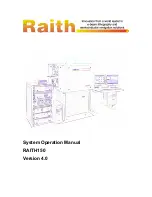
5
English
2 - Safety
n
Install safety valves on the refrigeration circuis to a piping network
that can channel any overflowing refrigerant outside
n
remove any leak of fluid inside and outside the unit
n
collect the waste liquids and dry any oil spillage
n
do not store flammable liquids near the unit
n
do not disperse the refrigerant and the lubricating oil to the
atmosphere
n
do not approach flames or other sources of heat to refrigerant
pipes; welding must be carried out whilst the pipes are empty and
purged with Oxygen Free Nitrogen (OFN)
n
do not bend/hit pipes containing fluids under pressure
2.5 Precautions during maintenance operations
Maintenance operations can be carried out by authorised technicians
only.
Before performing any maintenance operations:
n
Make sure a sufficient forced ventilation is present in the room
(>500 m3/h)
n
If brazing is needed, make sure to completely empty the refrigerant
circuit involved by flushing with OFN prior brazing works and
assure that OFN flow comes through
n
disconnect the unit from the mains with the external disconnecting
switch
n
place a warning sign “do not turn on - maintenance in progress”
on the external disconnecting switch. If possible, the isolating
device should be locked off
n
make sure that on-off remote controls are inhibited
n
wear suitable personal protective equipment (helmet, safety
gloves, goggles and shoes etc.)
To carry out any measurements or checks which require the
activation of the machine:
n
work with the electrical board open only for the necessary time
n
close the electrical board as soon as the measurement or check
has been completed
The following precautions must be always adopted:
n
do not release the fluids of the refrigeration circuit in the
surrounding atmosphere
n
when replacing an EEPROM or electronic cards, use always
suitable devices (extractor, antistatic bracelet, etc.)
n
to replace the pump, the evaporator or any other weighty element,
make sure that the lifting equipment is consistent with the weight
to be lifted
n
contact manufacturer for any modifications to the refrigeration,
hydraulic or wiring diagram of the unit, as well as to its control
logic
n
contact manufacturer if it is necessary to perform very difficult
disassembly and assembly operations
n
use only original spare parts purchased directly from manufacturer
or the official retailers of the companies on the recommended
spare parts list
n
contact manufacturer if it is necessary to move the unit one year
after its positioning on site or if you wish to dismantle it.








































